

Thermocoupler guide.pdf. Thermal Switch from RS Spares.pdf. What is a thermistor. Complete-Catalogue-nz.pdf (application/pdf Object) NTC and PTC Thermistor Temperature Sensor, Thermistor Temperature Probes and Instruments Suppliers and Vendors. How Bearings Work" Buy thermal switch online from RS Components. Measurement Standards Laboratory of New Zealand. Technical Guides are published by the Measurement Standards Laboratory to provide assistance with measurement techniques.
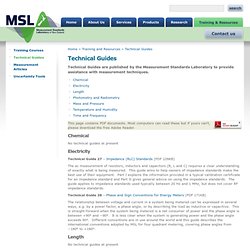
Chemical No technical guides at present Electricity Technical Guide 27 – Impedance (RLC) Standards (PDF 226KB) The ac measurement of resistors, inductors and capacitors (R, L and C) requires a clear understanding of exactly what is being measured. Technical Guide 28 – Phase and Sign Conventions for Energy Meters (PDF 171KB) The relationship between voltage and current in a system being metered can be expressed in several ways, e.g. by a power factor, a phase angle, or by describing the load as inductive or capacitive. Length Photometry and Radiometry Mass and Pressure Technical Guide 6 - Magnetic Effects in Weighing (PDF 237KB) An introduction to magnetic effects in weighing and how to avoid them.
Technical Guide 7 - Calibrating Standard Weights (PDF 475KB) How to calibrate standard weights to a best accuracy of 1 part in 106. Revised version with improved examples. RTD vs. Thermocouple comparison chart « Ultra Electronics Nuclear Sensors & Process Instrumentation (NSPI) Resistance Temperature Detectors (RTDs) Resistance Temperature Detectors (RTDs) are sensors that measure temperature by correlating the resistance of the RTD element with temperature.
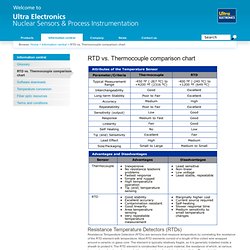
Most RTD elements consist of a length of fine coiled wire wrapped around a ceramic or glass core. The element is typically relatively fragile, so it is generally installed inside a sheath to protect it. The RTD element is constructed from a pure material, the resistance of which, at various temperatures, has been documented by various international standards institutes. The material has a predictable change in resistance as the temperature varies; it is this change that is used to determine temperature. Resistance thermometer. Resistance thermometers, also called resistance temperature detectors (RTDs), are sensors used to measure temperature by correlating the resistance of the RTD element with temperature.
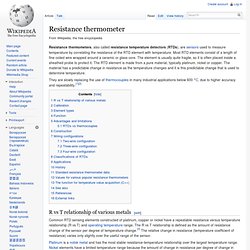
Most RTD elements consist of a length of fine coiled wire wrapped around a ceramic or glass core. The element is usually quite fragile, so it is often placed inside a sheathed probe to protect it. The RTD element is made from a pure material, typically platinum, nickel or copper. The material has a predictable change in resistance as the temperature changes and it is this predictable change that is used to determine temperature. They are slowly replacing the use of thermocouples in many industrial applications below 600 °C, due to higher accuracy and repeatability.[1][2] [edit] JUMO eTRON T - Digital Thermostat. Omron E5CN/E5CN-U Basic-type Digital Temperature Controllers. XU2HI / XU2HN (In-Head, 2 Wire) USB Programmable - RTD and Thermocouple Temperature Input Transmitter. Product Specifications: Download XU Sales Brochure Download XU2HI (Isolating) Installation Guide Download XU2HN (Non-Isolating) Installation Guide Download XU Programming Software Note: Requires the XU-USB programming key.
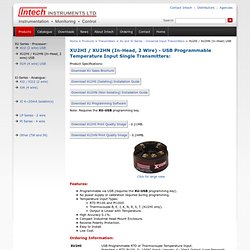
Download XU2HI Print Quality Image - 0.21MB. Download XU2HN Print Quality Image - 0.24MB. Click for large view Features: Programmable via USB (requires the XU-USB programming key). Ordering Information: Note: The tables below show the USB programmable input types etc for the XU2HI / XU2HN: The XU2HI / XU2HN can be pre-programmed before dispatch or are easily programmed using the XU-USB programming key and the free XU programming software. dTRANS T01 2-wire transmitter (707010) LPN-R-H - In Head RTD Pt100 Transmitter. Product Specifications: Download Installation Guide For information on the older LPN-R-H version.
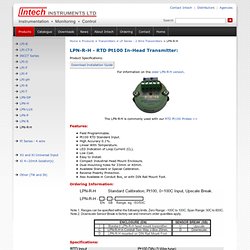
The LPN-R-H is commonly used with our RTD Pt100 Probes >> Features: Field Programmable. ABB Pt100 Temperature Sensor - Temperature Measurement Products (Measurement Products) JUMO Process Control, Inc. RTD Resistance Temperature Detectors. WMR - Wall Mounted RTD Assembly. Features: RTD Pt100 DIN Standard element Maximum temperature rating 110ºC Sheath materials 304SS and 316SS Optional head-mount transmitter - Models: XU2HI (Isolated), XU2HN (Non-Isolated) PVC Conduit Head Black Alloy Head Specifications and Ordering Information: * 316SS material available on request.
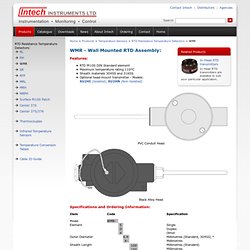
SR - Sanitary RTD Assembly. Features: RTD Pt100 DIN Standard element 3-Wire RTD configuration Maximum temperature rating 260ºC All sheath material 316SS Optional fast response tip Optional head-mount transmitter - Models: XU2HI (Isolated), XU2HN (Non-Isolated) Environmental Rating IP67 Stainless Steel Head Large Polypropylene Head Large Aluminium Head Specifications and Ordering Information:
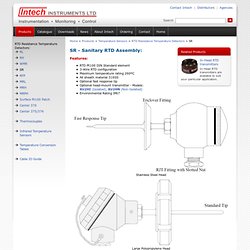
Temperature Sensors. Temperature Sensors. Features: RTD Pt100 DIN Standard element Maximum temperature rating 260ºC Sheath material 316SS Sheath diameters from 3.3mm to 6.4mm Various Lead Insulation Materials (Silicone Rubber, Tefzel, PVC) Small Diameter Probe with Collar to Adapt to Large Lead Optional Wall Mount Bracket Optional Sliding Flange Optional Compression Fitting. XU and XJ Series - Universal Input Transmitters. XU4.pdf (application/pdf Object) Temperature Sensors. MTL - Mineral Insulated Thermocouple with Leads. Features: K, J, T and N calibration Temperature range from -200 to +1250ºC Isolated and bonded hot junctions Various sheath materials for different environments (Inconel 600, 310SS, Cupro Nickel, Nicrobell) Sheath diameters from 1.0mm to 10.8mm Various Lead insulation materials (PVC, FibreGlass, Stainless Steel Overbraid, Stainless ArmourFlex) Specifications and Ordering Information: *1 Inconel is a registered trade name of Henery Wiggin & Co Ltd. *2 Nicrobell is a trademark of Nicrobell Pty Ltd. *3 Stainless Steel OverBraid - SOOB. *4 Standard size Plugs and Jacks only.
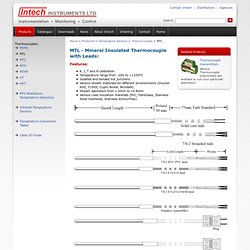
Note: The above covers the more common Thermocouple probes. We can supply probes to your particular specification. UT - Universal Thermocouple. Features: K and J calibration Maximum temperature rating 400ºC Various Lead Length Fibreglass insulated lead with stainless steel overbraid (SSOB) Specifications and Ordering Information: Note: The above covers the more common thermocouple probes.
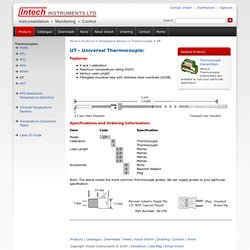
We can supply probes to your particular specification. Pt100 air temperature sensor. RTD-805_RTD-806.pdf (application/pdf Object) RTD (PT100) Probes, Elements and Assemblies : RTDs Product Finder. PT100 sensors (Platinum Resistance Thermometers or RTD sensors) Platinum resistance thermometers (PRTs) offer excellent accuracy over a wide temperature range (from -200 to +850 °C).
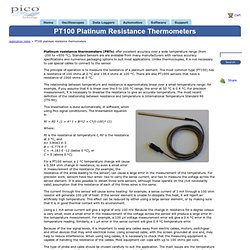
Standard Sensors are are available from many manufacturers with various accuracy specifications and numerous packaging options to suit most applications. Unlike thermocouples, it is not necessary to use special cables to connect to the sensor. The principle of operation is to measure the resistance of a platinum element. The most common type (PT100) has a resistance of 100 ohms at 0 °C and 138.4 ohms at 100 °C. There are also PT1000 sensors that have a resistance of 1000 ohms at 0 °C. The relationship between temperature and resistance is approximately linear over a small temperature range: for example, if you assume that it is linear over the 0 to 100 °C range, the error at 50 °C is 0.4 °C. This linearisation is done automatically, in software, when using Pico signal conditioners. CONTROL TEMP DGTL VOLTAGE OUT - E5CS-Q1KJX-F. Omron pt100 datasheet and application note, data sheet, circuit, pdf, cross reference, pinout.
4-20ma Pt100 Temperature Transmitter-4-20ma Pt100 Temperature Transmitter Manufacturers, Suppliers and Exporters on Alibaba. High Accuracy PT-100 Temperature Sensors. Platinum resistance thermometers (PRTs) offer excellent accuracy over a wide temperature range (from -200 to +850 °C). Sensors are interchangeable between different manufacturers, and are available in various accuracy ratings and packages to suit most applications. Unlike thermocouples, it is not necessary to use special cables to connect to the sensor.
We supply a range of Class A, Class B and tenth–DIN sensors. Specialist manufacturers can provide sensors with 0.001 at 0 °C accuracy (at a price). Please note that the accuracy specifications stated below relate to the SENSOR ONLY. For more information please see our application note on choosing PT100 sensors. General Purpose / Low–Cost PT100 Probes. What is a motor thermistor. Engine temperature sensor. Engine Temperature Sensor - Bimmerforums - The Ultimate BMW Forum. Bosch - Oxygen Sensors. Can anyone tell me what does an Engine Temperature Sensor do? and what if the Sensor is malfunctioned. ECT (Engine Coolant Temperature) Sensor. An ECT sensor, or Engine Coolant Temperature Sensor is a sensor that is screwed into the engine's block or cylinder head and is used to determine the temperature of the engine coolant.
The ECT sensor is basically a thermistor that changes resistance with temperature. When the ECT (engine coolant temperature) is high (hotter), the resistence is low, and when the ECT is low (cooler) the resistence is high. This resistance reading is sent to the vehicle's PCM/ECM (car's onboard computer) and is or can be used to activate emission controls or turn the engine's cooling fan on.
The ECT sensor is usually a two wire sensor that uses a 5 volt reference from the PCM with a ground signal back to the PCM. In general terms if the ECT reading is cold the reading could be less than 0.5 volts (on the ground signal) and when the engine is hot the reading could be around 4 volts. Here is a photo of one ECT sensor: This informative video provides information on testing and replacing automotive ECT sensors.